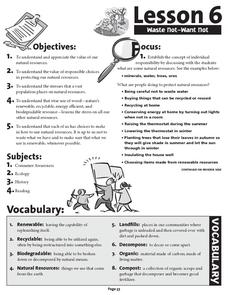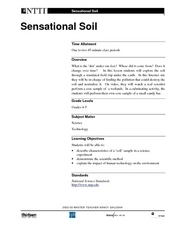Curated OER
Save the Earth: It's Everyone's Home!
Students research ways to conserve and reduce energy and resources. For this reducing waste lesson, students work in teams to experiment with water and losing resources. students brainstorm about ways to conserve and reduce energy and...
Curated OER
Wasting Times
Students examine Britain's waste management proposals. In this environmental stewardship lesson, students visit linked websites to gain an understanding of proposals to reduce waste in the nation.
Curated OER
How Long Does Trash Last
Students work in cooperative groups to estimate how long trash lasts in a landfill. They study environmental consequences of not recycling and use graph-making software to create a graph that illustrates the lifespan of trash items...
Curated OER
100 Things You Can Do to Save the Planet
Students examine the possible ways to recycle, reuse, and re-imagine products and objects in order to reduce pollution and waste on our planet. In this 100 things you can do to save the planet activity, students take three actions to...
Curated OER
Recycling
Students investigate how to reduce, recycle, and reuse items in order to conserve natural resources. They complete a trash graphing activity after discussing different types of trash. Finally, the examine ways to buy recycled products to...
Curated OER
Aluminum Can Drive
Second graders complete a recycling project to clean-up their school. In this service project lesson, 2nd graders assess their campus for litter, set up a recycling project, clean up their campus, and recycle the trash. Students also...
Curated OER
Litter From Lunchtime
Students explore environmental care by participating in a litter identification activity. In this food trash lesson plan, students discuss the destruction litter causes in our environment and ways we can avoid littering ourselves....
Alabama Learning Exchange
Waste Not, Want Not
Pupils determine what materials are able to be recycled. In this environment protection activity, learners read The Three R's: Reuse, Reduce, Recycle and discuss landfills. They are given an item to decide if it can be recycled. They...
Curated OER
Earth Kids: Kindergarteners Taking Care of the Earth
Students explore a variety of ways of how to care for the environment in the nine lessons of this unit. They observe how to be responsible "Earth Kids."
Curated OER
ESOL Environment and the World
Pupils examine a recyling bin and the many different items that can be recycled. They practice loading the recyclie bin and using the correct vocabulary to explain each item.
Forest Foundation
Waste Not - Want Not
Recycling is the focus in the sixth of a nine-lesson series devoted to forest ecosystems. Class members read an article about the responsible use of natural resources and ways to reduce land fill.
Curated OER
Sensational Soil
Fourth and fifth graders explore soil by taking a simulated field trip under the earth. They go to an Internet site that runs a simulation which charges them with finding a source of pollution that could destroy all of Earth's soil, and...
PBS
Twirling in the Breeze
Blow classes away with a hands-on lesson investigating wind speed. Learners use common materials to design and construct anemometers. They then test their anemometers and collect data on the wind speed created by a fan.
Curated OER
Solid Waste/Recycling
Students see that when we throw away garbage, it usually ends up in a landfill. Landfill space is getting increasingly scarce, and every time we throw something away we throw with it the energy, the money, and the raw materials it took...
Montana State University
Climb into Action!
Climate change affects even the largest and intimidating of landforms—even Mount Everest! A resource helps teach learners the connection between global climate change and its effects on Earth. Activities include videos, class discussion,...
Curated OER
Are you going to eat that?
Learners identify and define composting. STudents compare and contrast aerobic and anaerobic composting. Students illustrate the benefits of composting and other methods to reuse, recycle, reduce, and respond. Learners identify through...
Curated OER
Think Green
Students experience and practice compositing and recycling through hands-on-activities. They distinguish between which items from their trash can be recycled, composted and reused. The process for making recycled paper is also covered in...
Curated OER
Dumptown Game
Students engage in an interactive play scenario. They are the new managers of a fictional city and live in a place where nothing is recycled. Students are faced with various problems that need to be solved. They work together to propose...
Curated OER
Performance Art and The Waste Stream
Students research local waste management services, discuss findings, give opinions about what they have found, offer solutions and ideas, and create performance art, design art works, and fine art works to convey information on waste...
Curated OER
Buying in Bulk
Students investigate buying purchases in bulk. In this buying in bulk lesson, students consider ways to cut costs and reduce waste in landfills by making bulk purchases.
California Academy of Science
Energy: A Day in My Life
If only we could harness the energy of fifth graders, our energy problems would be over! The class discusses where different forms of energy come from and how we use them. They complete a chart of the activities that they do daily...
Curated OER
Create, Design, and Invent with Plastic
Young scholars explore creative ways to reuse materials. In this ecology/art lesson, students create artwork using trash. Young scholars view examples of folk art from around the world that used waste products as a main component.
Curated OER
Reduce and Reuse
Students conduct a lunch waste audit by recording each item they throw away at lunch. They graph class lunch waste. They use this information to devise a plan of action to reduce lunch waste. There is also an activity to make paper.
Curated OER
Invention
Students create an invention, or simple machine, out of items taken from the recycling bin. Students draw diagrams of their proposed inventions, then create simple machines.

























